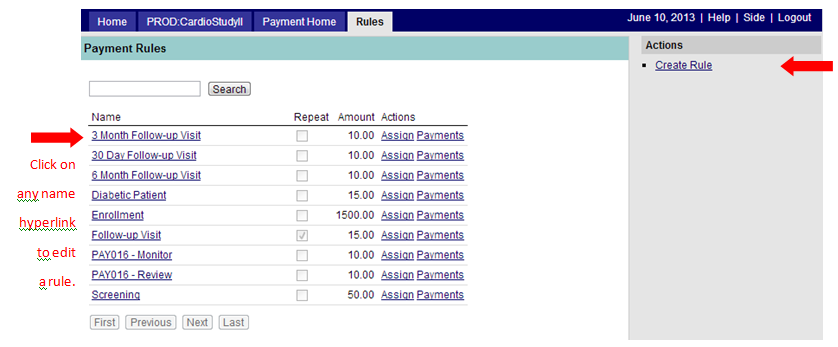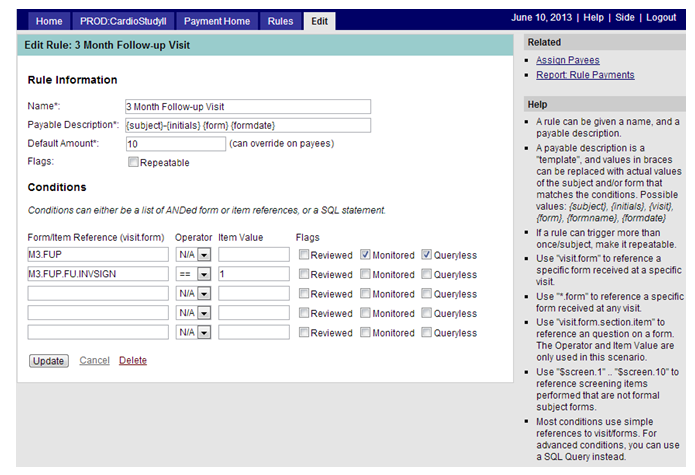Payment rules are established to allow payments when certain conditions are met. Typically a single set of payment rules is applied to all sites, however, there could be payment variations among sites, particularly on amounts. If payment conditions differ among sites, each may require their own set of rules. (Libra Medical staff typically sets up the payment rules.)
The list of rules established for a study may be viewed by first clicking on the Home hyperlink from the Payments Module in the Study Landing Page as shown in Figure 1 below. Once in the Payments Landing Page, under Setup Tasks, select Setup Rules, as shown in Figure 2 below.
Figure 1: Study Landing Page - Payments

Figure 2: Payments Landing Page

You’ll arrive at the Payment Rules Landing Page as shown in Figure 3 below. Any existing rules created for the clinical trial will be visible in this page.
To create a new rule, click on Create Rule in the Actions sidebar. The Create Rules page is shown in Figure 4 below. To edit a rule, click on the underlined Name hyperlink shown in Figure 5 below. Click "Update" to save.
Figure 3: Payment Rules Setup

Figure 4: Create (Payment) Rule Page

The available fields in the Create Rule page are described in the table below:
RULE INFORMATION |
|
Name*: |
Enter a meaningful name for the rule (e.g. associated with a study visit interval, test, screening item, activity.) (See examples in Figure 3 above.) (*Required field.) |
Payable Description*: |
Enter a description for the rule using {field names}, which will be replaced with the actual value of the fields from the subject’s CRFs. (*Required field.) [Note: When citing multiple fields, separate field names with characters or spaces.] Example: {subject}-{initials} , {formname}: {formdate} which translates to: 001-026 – SEJ, 3 Month Follow-up Visit: 10-Jun-2013 Field names:
|
Default Amount*: |
The amount to be paid (per the currency designated on the Contact page). Enter the number alone, without the currency character (e.g. 100). (*Required field.) |
Flags: |
Click on the “repeatable” box if the rule applies to more than one subject. |
CONDITIONS |
|
Form/Item Reference (visit.form): |
Note: Before entering conditions, obtain the visit/form/section/item field names, or the indicator number for screening, from the database programmer. You may indicate up to 5 forms or fields in one statement. Reference a form at any visit as “*.FormName”. Reference a form at a specific visit as “VisitName.FormName”. Reference a form item (question) as “VisitName.FormName.SectionName.ItemName”. For screening candidates, use “$SCREEN.Number”, where number is “1..10”. Use "visit.form.section.item" to reference a question on a form. Only the Operator and Item Value are used in this scenario. Any more complicated condition will require a database programmer to set the SQL-based condition. The conditions can be modified at any time and will be used when the next “Generate Payables”. |
Operators: |
= equal != not equal |
Item Value: |
Note: Obtain the item value from the database programmer as the value may be coded as a number. |
Flags: |
There are three possible flags: Reviewed, Monitored and Queryless. Choose one or more flags that represent the condition/s desired. If more than one flag is chosen, the values returned will reflect all flags chosen (AND statement, not OR). |
Figure 5: Edit Payment Rules Page
